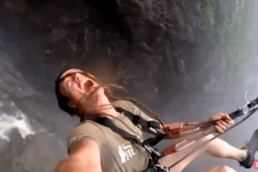In the Winter 2015/16 issue of Kootenay Mountain Culture magazine we ran an article describing writer Vince Hempsall’s experience doing a tandem BASE jump off the Perrine Bridge in Idaho.
For those who have yet to read the article, “BASE” stands for the four objects people parachute off of namely buildings, antennae, spans (or bridges) and the earth, such as cliffs.) He did the jump with professional skydiver, BASE jumper and wingsuit pilot Sean Chuma and a large part of their conversation after the jump was about the dangers of the sport. In fact, within two months of Vince’s experience, five people died in the United States while BASE jumping, including professional athlete Dean Potter. As a follow-up to our original article we present a Q&A with one of the world’s best BASE jumpers, Sean Chuma, about why he participates in one of the most dangerous sports in the world.
Hey Sean, how long have you been BASE jumping?
For nine years, but I’ve been skydiving since 1996. I wanted to skydive since I was eight but legally couldn’t until I turned 16, which is when my parents got me a jump for my birthday. I used my college funds to buy a parachute…(eventually) I did go to school and got a degree in psychology working with kids but when I wasn’t doing that, I’d jump. The first time I BASE jumped was in 2006 and by then I had done about 700 skydives.
And how long have you been doing tandem BASE jumps?
Over time I built up a good reputation as an aerialist and BASE jumper and people started asking me to teach them so that’s how my school got started. I ensure people have at least 200 skydives under their belt because there’s less time and less room to navigate. But for those who don’t want to spend the time and money to do all those skydives, we offer tandem jumps. We got some custom gear made and did about 50 test jumps with friends. That was late 2009. Now I’m offering jumps off the Perrine Bridge in Idaho (where I live) as well as specialty jumps in exotic locales for people who can afford it and specialty jumps for people who have mobility issues.
You also do wingsuit flying. What’s the difference between that and BASE jumping?
Wingsuit flying is a form of BASE jumping. You wear a specially designed suit and you jump off higher stuff because you need to get up enough speed to start flying. Also, flight times are longer because you’re gliding at an angle rather than straight down. It’s like being a super hero!
Why do you do it?
I do it ‘cause it’s fun. I’m not doing it to get high on adrenaline. It’s a celebration of life. I love to fly. I always have felt a desire to be in the air, above the surface of the earth. Maybe I was a bird in a past life.
What are the dangers involved?
One of the dangers is the chute opening facing the cliff you’ve just jumped off of. You might only have a couple of seconds to turn it around. But I want to be clear about something: it’s not about being crazy. A lot of people call us adrenaline junkies but most BASE jumpers are intelligent and think things through. It’s very calculated. There’s a lot more involved than just jumping off something. First we get the training and then we take into consideration different factors before each jump such as wind speed, landing area and even the humidity.
Yet people die.
I’ve done over 3,000 BASE jumps now yet I experience probably more fear than some people because I’ve seen friends die and I’ve had bad accidents myself. There are some guys who want to progress too fast and that can hurt the sport. The guys you see wingsuit flying on YouTube have been doing it for years and years and if you want to be like those guys but want to get there by next year, well you’re on a fast track to tragedy. In a sport where there’s no mistakes allowed, you don’t want to do things that are beyond your level. You have to progress slowly. Patience is so important in this sport.
What was your accident?
Four years ago I did this jump and threw out the pilot chute (the small parachute that catches the wind and opens the larger chute) and the pins weren’t popping – it was a weird little malfunction with this gear that I was trying out. As a result I flipped onto my back and the parachute opened between my legs and my left foot got bent outwards and it tore the ligaments in my leg. It almost tore my leg right off. That was a year of serious recovery.
Have you ever said “No” to a jump?
Yeah, I’ve walked away from jumps quite a bit. I have a business and my business is creating a positive outlook on the sport for “normal” people who don’t have parachute experience. I’m introducing BASE jumping to the masses. If the conditions aren’t right, we just don’t go. I can’t afford to put people in danger.I don’t want to hurt them or me or the sport I love. If it means someone gets angry because they drove all the way and missed their window then so be it. Better angry than injured.
What about if a client says “No” at the last minute and you have to bail?
Look, people understand what’s going on. No-one’s going to call you a pussy for not jumping. We get that this is all about concentrating and trying to control the fear. It helps you get to know yourself a lot. If you don’t acknowledge that you could possibly die doing this, then you’re a fool. Things happen. It’s kinda like driving but no-one’s out there trying to stop people from getting in their cars. BASE jumping is all about decision making. That’s the biggest skill in the whole sport. If the conditions aren’t perfect but you decide to jump anyway, you’re stacking the odds against you. Sure BASE jumping is dangerous but it can be done safely if you’re smart about it.
What does the future of BASE jumping look like?
There are more people doing it than ever before but we’re self regulated, which is working pretty well right now. That said, we all have to be ambassadors of our sport. Soon there’ll have to be stronger ethics amongst BASE jumpers – there will have to be a group mentality about preserving the sport rather than people being selfish and wanting a cool experience jumping off an illegal building for example….Exposure has always come in waves. The media will attach itself to the negative side of things because it’s easy to write about. But that only goes so far before we’ll all be forced to focus on the positive side of the sport: this is something to celebrate! It’s evolution of man towards way better stuff – we’re not limited to the earth anymore. We’re doing super hero stuff.
Vince Hempsall
Vince Hempsall lives in the beautiful mountain town of Nelson, British Columbia, where he spends his time rock climbing, backcountry skiing and mountain biking (when not working). He is the editor of Kootenay Mountain Culture Magazine and online editor for the Mountain Culture Group.
Related Stories
Award-winning BASE Jumping Short Film “The Flip” Released Online Today
The BASE jumping short film "The Flip" won the 2019 National Geographic Wild To Inspire Short Film Competition. It…
Interview with Sherpas Cinema
It's one of the most eagerly anticipated ski films in recent memory, with a trailer that blew minds with its lure of…
World Exclusive: Numinous Ski Film Trailer and Interview
One of the most beautiful backcountry ski movies of all time is about to drop and Coast Mountain Culture magazine is…
The Craziest Rope Swing in The World
Oh. My. God. This is absolutely terrifying. The look on their faces tells you just how terrifying it must have…
2012 Freeskiing and Freeride World Tour
2012 Freeskiing and Freeride World Tour was in Revelstoke BC on Jan 4-11. Mens Results, -Canadian Kye Petersen took…








